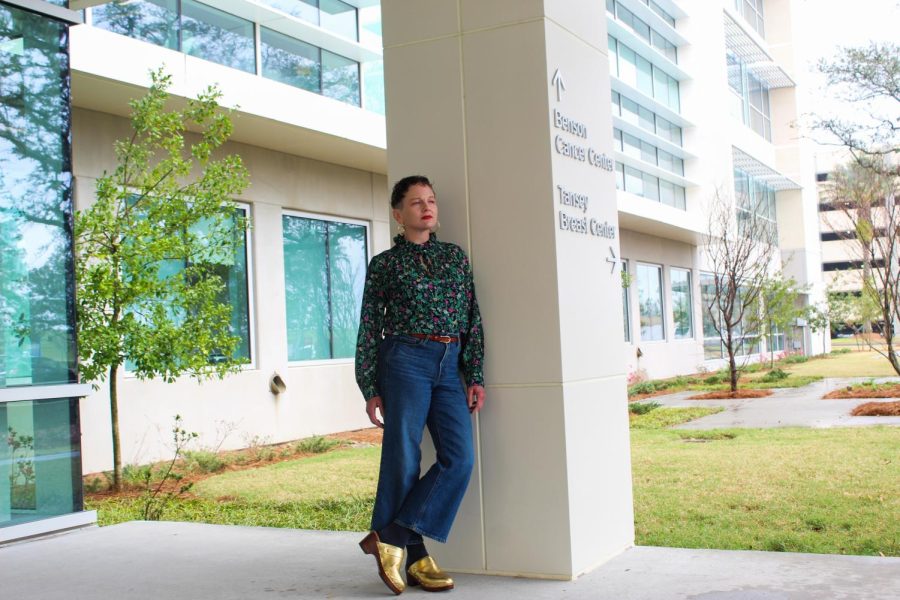Louisiana fails women’s health care
Christy Lorio looks on at an Ochsner Medical Center in front of the hospital’s Benson Cancer Center March 10, 2022. Lorio was diagnosed with colorectal cancer in 2018 and said she’s experienced disparities in women’s health since then.
March 17, 2022
Christy Lorio felt like the rug had been swept from under her feet when her doctor diagnosed her with colorectal cancer at the age of 38 in June of 2018.
She still couldn’t believe her ears when she underwent pelvic radiation to kill her cancer cells in March 2019, and her doctor, an older White man, nonchalantly told her she wouldn’t menstruate or be fertile anymore, she said.
“Unless you have some kind of patient advocate or somebody who’s been through what you’ve been through, you are in some ways left on your own to figure things out,” she said.
Lorio said she didn’t even know what hot flashes were before she started getting them and that she wouldn’t have known treatment was available to her during remission if she had not gone to see a survivorship doctor.
Lorio’s story plays out every day in thousands of women’s experiences with the Louisiana healthcare system, according to Dr. Sara Reardon, a board-certified pelvic floor physical therapist. Reardon, also the owner of NOLA pelvic health, said Louisiana has one of the highest maternal mortality rates in the country and a grade F in maternal health care.
Why disparities in women’s health happen
Lannie Guidry, a family nurse practitioner at Loyola’s Student Health Services, said that the reason women experience health care disparities in the state of Louisiana is a “big huge ‘why?’”
But Guidry said that health care disparities encapsulate many things, including the fact that Louisiana is a poor state and has a lack of education surrounding its health care systems.
She said that there are rural areas in Louisiana where women don’t have the same access to doctors and health education as those in urban areas. Guidry said the fact that nurse practitioners can’t practice on their own is also a part of the problem.
She said that as a nurse practitioner, she’s been fighting to practice on her own since the beginning of her career in an effort to reach more people of Louisiana, but state law still doesn’t allow for it. Guidry said that disparities in women’s health care also typically rolls over to children.
As an employee in a pediatric emergency room in Baton Rouge, Guidry said she saw young mothers bring their children to the hospital without being educated on what was happening to them.
Guidry said that parents didn’t know seemingly obvious ways to care for their children, including how to dose medicine, treat diaper rashes, and when to bring their children to the emergency room or stay home.
Parents were also uneducated about sudden infant death. She said she saw children die because their parents didn’t know that they weren’t supposed to rest their infants on a pillow.
“Those kinds of things were really sad to see,” Guidry said. “They were so uneducated. They need more outreach. They need more education.”
Guidry said that the COVID-19 pandemic has worsened the lack of education that she said leads to health care disparities, specifically those that impact women and children.
Because many healthcare professionals are experiencing burnout, providers feel like they need a break right now and like it’s hard to educate, Guidry said. But regardless she said it’s time for physicians to jump back to educating their patients.
Therefore, Guidry said women in Louisiana, and especially women of color who are predisposed to a higher rate of infant and maternal mortality, deserve outreach programs that will teach them about their bodies and how to care for their children.
Women’s health disparities’ consequences
Like Guidry, Reardon said that communities of color especially suffer the consequences of women’s health care disparities.
Reardon said that in order to bridge the gap, providers need to focus on educating women on their experiences throughout every stage of life. Reardon said that women should be prepared mentally and physically about what puberty, sex, pregnancy and postpartum healthcare entail. She said it is their physicians’ responsibility to educate them on these topics.
Reardon said most women’s health care concerns during pregnancy focus on babies rather than moms. For example, Reardon said there’s “very little focus” in the system on preparing women for birth.
And after birth, Reardon said the disparities are even more alarming. Women typically receive one visit postpartum six weeks after giving birth, and 40% of women don’t even go to the appointment.
“Why aren’t we giving women the support they need?” Reardon said, arguing that there is little to no follow up in a woman’s postpartum care post childbirth.
Reardon said that women need mental health and physical support after giving birth. They also need pelvic floor physical therapists to help their bodies recover comfortably, according to Reardon.
But Reardon also said the system simply prevents her from being able to do anything at all.
Louisiana has a high cesarean section birth rate, for example, according to Reardon. She said this is because providers might push for a surgical procedure earlier than necessary because of systemic issues that lead to an overcrowded hospital that needs to put its next patient in a room.
And although the American College of Obstetricians and Gynecologists in 2018 said moms should check in three weeks postpartum and continue care for another nine weeks, Reardon said she barely sees the new standard followed.
“I don’t know where that’s happening, but it’s not happening here,” she said. “I think we always do what was always done because that’s how we’re wired.”
But Reardon said that with advances in science and technology, she hopes that things will change, though she said the fight is difficult as a physical therapist opposing entire healthcare systems.
“I feel like David versus Goliath here,” she said.
Struggles from policy
Reardon encouraged women to advocate for themselves and noted that in Louisiana, patients can see a pelvic floor physical therapist without a physician’s referral.
Another systematic discrepancy that impacts patients are finances, specifically regarding struggles with insurance, Lorio, Reardon, and Guidry agreed.
Part of the reason Lorio said she chose to pursue a masters degree in studio arts at the University of New Orleans was to stay on the school’s student health insurance.
But when her insurance was dropped at UNO, Lorio said it put her in a scramble to get private insurance. Although she was on disability benefits, she didn’t meet the threshold for Medicaid, which requires that patients are on benefits for two years.
Instead, she got a private plan with the help of her husband, who is a mental health care provider.
“These policies are written to where you basically have to have a Ph.D. in health insurance to navigate all of this,” Lorio said, adding, “It’s just frustrating having to deal with (insurance) when you have a life-threatening disease.”
Advocates are trying to make these processes easier for women in Louisiana, though they’ve already experienced shortcomings.
The Office of Health Equity in Louisiana proposed a bill last year in an attempt to establish an Office of Women’s Health, but it didn’t pass. Guidry said she thinks the main reason it didn’t make it through the government was because of what she perceived to be a mismanaged budget.
She said that the program wanted to pay the assistant secretary of the program an annual salary of $225,000 to make it happen. Guidry said that in budgeting that substantial of a salary for employees, policymakers are missing the point.
“If we aren’t prioritizing health over profit, something like this isn’t going to pass,” Guidry said. “These people are poor, and they are uneducated, and we need to focus.”
Prioritizing advocacy
Reardon argued that advocating for bills that will cover maternity or parental leave as well as donating and getting involved with nonprofits would help bridge the gap in women’s health care.
Guidry also suggested getting nurse practitioners to go to schools in the city to talk to teenage girls about their bodies, pregnancy, birth control and safety in general.
Patients can also be their own advocates, according to Guidry, who encouraged people to reach out to their providers.
“I know it’s hard to make that first step but ask a question,” she said. “Talk to somebody.”
Editor’s Note: This story was last updated on March 18 to reflect that Lorio was 38 when she was first diagnosed with colorectal cancer.








